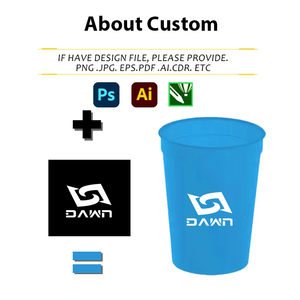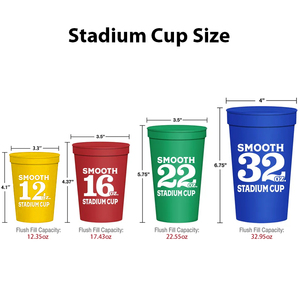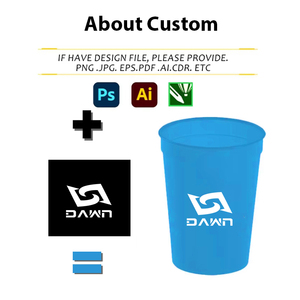
All categories
Featured selections
Trade Assurance
Buyer Central
Help Center
Get the app
Become a supplier

(7445 products available)















































Vintage plastic cups are containers made from plastic material. They are often characterized by their retro or old-fashioned appearance. These are some common classifications.
Material Classification:
Vintage plastic cups were traditionally made from materials like polyvinyl chloride, polystyrene, and acrylic. PVC cups are flexible and resistant to chemicals, making them suitable for various beverages. The rigid and durable, yet shatter-resistant, cups made of polystyrene are ideal for high-use environments. Cups made of acrylic are lightweight, impact-resistant, and have a sleek appearance, making them appropriate for both casual and formal settings. These materials contributed to the practicality, durability, and affordability of vintage plastic cups, which were widely used in homes, restaurants, and events.
Design Classification:
Vintage cups were designed with ornate patterns and flourishes, including details like lace, floral motifs, and intricate embossing. These fanciful designs were inspired by traditional glassware and added a touch of sophistication to parties and gatherings. Vintage fancy plastic cups came in a variety of colors, including clear, which allowed the contents to be seen, as well as bold and vibrant hues that matched different themes and color schemes. Common colors included gold, silver, red, blue, green, and pink. The color options allowed for coordination with decorations and contributed to the visual appeal of the event.
Usage Classification:
Vintage plastic cups were commonly used in parties, gatherings, and events where disposable tableware was preferred. They provided a stylish and convenient option for serving beverages without the need for washing and reusing. Vintage plastic cups were offered in a variety of sizes to accommodate different types of beverages. Smaller cups were suitable for serving drinks like soda, juice, and water. In contrast, larger cups could hold beer, cocktails, and other mixed drinks. The varied sizes allowed for the appropriate serving of beverages based on the needs of the event.
Vintage plastic cups came in many different designs. Some were simple and practical for everyday use, while others were fancy and decorative.
Sleek and Minimalistic Designs:
Vintage plastic cups with simple lines and elegant curves looked modern and stylish. They had a minimalist design with no frills or extra decorations. This made the cups perfect for everyday use in homes, offices, and restaurants where people preferred a clean and neat appearance.
Intricate Patterns and Embellishments:
Fancy vintage plastic cups stood out from ordinary ones because of their detailed patterns and decorative features. These cups were designed with great care. They had pretty details like floral motifs, geometric shapes, and elaborate borders molded right into the plastic or printed onto its surface. Some even included adornments such as gold or silver accents, embossed textures, or delicate lace-like designs. The intricate patterns made each cup look special and fashionable, suitable for elegant events or as eye-catching pieces in any setting.
Playful and Whimsical Creations:
Vintage plastic cups were also designed to be fun and full of imagination. These cups stood out because they had bright colors, unusual shapes, and interesting details. For example, some cups came in the shape of animals or had handles that looked like twisting vines. They were decorated with lively patterns featuring polka dots, stripes, and cartoon-like drawings. The playful cups brought joy and a sense of excitement. They were perfect for children's parties, casual gatherings, or anywhere people wanted to add some fun and creativity.
Vintage plastic drinking cups are still relevant because of their flexible and practical nature. Some of the common usage scenarios include:
Hospitality industry
The hospitality industry uses reusable vintage plastic cups for room service. The use of colorful plastic cups adds a playful and retro touch to poolside and beach bar events. During off-season or special promotions, these cups are used as giveaways. The vintage cups are used to serve drinks during special events such as weddings, anniversaries, and corporate gatherings.
Retail and commercial spaces
In retail and commercial spaces, vintage plastic cups are used as product display. The cups are used to display small items such as accessories, candies, and promotional samples. Some brands use vintage cups for marketing and promotional campaigns. The cups are distributed as merchandise or used as packaging for special edition products.
Healthcare and senior facilities
Healthcare facilities use vintage plastic cups for medication. The cups are used to contain and serve medications, making it easier for patients to adhere to their medication schedules. Due to their easy-to-hold nature, these cups are ideal for use by seniors and patients with mobility challenges.
Educational institutions
Educational institutions use vintage plastic cups in laboratories and science classes. The cups are used for experiments, demonstrations, and to contain small laboratory materials. Schools and daycare centers use vintage cups as art and craft materials. Children are encouraged to make creative projects using the plastic cups.
Office and workplace
Vintage plastic cups are used as desk organizers. The reusable cups are used to hold pens, pencils, brushes, and other stationery supplies. Some offices use vintage cups during meetings and training sessions. The cups are distributed to participants to hold water, coffee, and other beverages.
Home and personal use
Vintage plastic cups are used as party supplies. The reusable cups are easy to clean and can be reused for multiple events. When organizing children's parties, the vintage cups add a fun and colorful touch. The cups are used as craft supplies. The vintage cups can be painted, decorated, and transformed into various creative projects.
When choosing vintage plastic cups, consider the following factors:
Purpose:
Determine what the vintage plastic cups will be used for. Will it be for a special event, everyday use, or as decorative pieces? If using them for events, look for durable cups that can withstand frequent handling. If displaying them, prioritize unique designs and colors.
Style and design:
Vintage plastic cups come in many styles, from retro to mid-century modern. Decide on a style that matches the user's personality or complements their existing decor. Consider the cup's shape, patterns, and color options.
Condition:
If buying vintage cups from thrift stores or antique shops, inspect the condition. Look for cracks, chips, or signs of wear. Make sure the printing on the cup is still visible. Good quality vintage cups will have minimal damage. Some wear can add to the cup's charm if they are being used as decorative pieces.
Quantity:
Consider how many vintage plastic cups are needed. If hosting large events, make sure there are enough cups by buying a lot. Some sellers offer sets, which are great for collecting or using at parties.
Price and budget:
Set a budget before shopping. Vintage plastic cups can vary in price. More unique or rare designs may cost more. Stick to the budget to ensure a reasonable total cost.
Safety:
Vintage plastic cups may not meet today's safety standards. If concerned about using vintage cups for food or drinks, consider their safety. Look for cups labeled BPA-free plastic. BPA is a chemical commonly used in older plastic products that some people prefer to avoid.
Q1: Can vintage plastic cups be used safely today?
A1: Yes, vintage plastic cups can be safely used if they are made from food-grade plastics and are not worn out or damaged. However, it is important to check the material used in the cups to ensure it is safe for use. If the cups are made from older plastics, such as polyvinyl chloride (PVC), which may contain harmful additives, it is better not to use them. In addition, if the cups show signs of wear and tear, such as scratches or cracks, it is also advisable not to use them, as damaged plastic may release harmful substances.
Q2: How should vintage plastic cups be cleaned and stored?
A2: Vintage plastic cups should be hand-washed with mild soap and warm water, avoiding harsh detergents or hot water that could damage the plastic. To clean them effectively, one can use a soft sponge or cloth to wipe the surface of the cups thoroughly. It is also possible to use a soft brush to clean the crevices and patterns on the cup. After cleaning, the cups should be rinsed with clean water and dried naturally. For storage, the cups should be kept in a cool, dry place, away from direct sunlight and extreme temperatures, to prevent the plastic from aging or deforming.
Q3: Are vintage plastic cups environmentally friendly?
A3: The environmental friendliness of vintage plastic cups depends on the material. Some older plastics are not biodegradable and can contribute to environmental pollution. But now, many vintage plastic cups are designed to be reusable and recyclable, which can reduce their impact on the environment. When choosing vintage plastic cups, business buyers can consider using environmentally friendly materials, such as cups made from biodegradable plastics or recyclable materials, which will help reduce environmental impact.